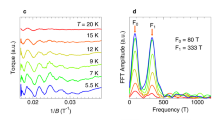Abstract
Experimental evidence suggests the operation of electron rules based on bond ordering of doped radical CuO bonds (BO) and lattice pressure (LP) in cuprate superconductivity. Ideas are developed for understanding the crystal chemical principles involved in these BO. They are then extended to materials on the basis of other electronegative elements. For cuprates, a quantitative T c formalism is based on radical bond or hole concentration in the CuO2 plane (hp) per O in the extended planar system including the apical O (radical formalism or RF). The deleterious effect of the apical O is ascribed to bond resonance with the CuO2 plane. A range in the critical hole concentration exists for optimal T c depending on LP. Accordingly the small Sr analogs tend to be limited at smaller hole concentrations h p = 1/6, while the Ba analogs can optimize at 1/3. Selected experimental evidence is used to construct plausible BO patterns. Superconductivity is related to strings of local pairs of trijugate half bonds. Electronic freezing can occur in domain walls of alternating single holes, e.g., in La2CuO4 type materials at h p = 1/8. Predictions for this BO model have been corroborated by details in the transistor doping of CaCuO2 and C 60 as a universal sequence of T c development with hole doping becomes apparent for both cases. Hallmarks include linear portions up to an optimal BO (RF slopes), which extrapolate to the origin, and a “sharp” peak with another linear region thereafter. They further include T c onset at a critical BO, where an adverse BO is cooperatively transformed to a beneficial one with a slope related to RF by rational numbers. Tendencies to electronic freezing [e.g., h p = 1/8 in CaCuO2 and an analogous one in C 60] occur near the optimal BO because of increasing LP. Some of these features occur at identical numbers of atoms per hole for both systems and others are related numerically. T c–hole slopes can supply hints for the mechanisms of BO transformations. The universality of this behavior suggests a common origin for all high T c materials in pairs of doped covalent bonds of radical character and a “musical” BO phenomenology with respect to levels and limits.
Similar content being viewed by others

References
A. Simon, Angew.Chem. Int. Ed. 36, 1788(1997).
R. Ricardo da Silva J. H. S. Torres, and Y. Kopelevich, Phys. Rev. Lett. 87, 147001(2001).
J. H. Schoen, C., Kloc, and B. Batlogg, Nature 408, 549(2000).
J. Nagamatsu, N. Nakagawa, T. Muranaka, Y. Zenitani, and J. Akimatsu, Nature 410, 63(2001).
H. Oesterreicher, J. Solid State Chem 158, 139(2001).
D. Ko and H. Oesterreicher, Physica C 277, 95(1997).
H. Oesterreicher, J. Low Temp. Physics 177, 993(1999).
H. Oesterreicher, J. Alloys Compd. 336, 138(2002).
H. Oesterreicher, J. Supercond. 14, 703(2001).
H. Oesterreicher unpublished.
J. H. Schoen, M. Dorget F. C. Beuran, X. Z. Xu, E. Arushanov M. Lagues and C. Deville Cavellin Science 293, 2430(2001).
Y. J. Uemura, Phys. Rev. Lett. 62, 2317(1989).
J. M. Tranquada, S. M. Heald, A. R. Moodenbaugh, and Y. Xu, Phys. Rev., 38, 8893(1988).
M. R. Presland and J. L. Tallon, Physica C 176, 95(1991).
J. L. Tallon, Phys. Rev. B 51, 12911(1995).
B. O. Wells, Science 277, 1067(1997).
E. S. Bozin, G. Kwei H. Takagi and J. S. L. Billinge, Phys. Rev. Lett. 84, 5856(2000).
T. Egami, Y. Petrov, and D. Louca, J. Supercond. 13, 709(2000).
M. W. Pieper, F. Wiekhorst, and T. Wolf, Phys. Rev. B 62, 1392(2000).
J. M. Tranquada, Phys Rev. B 50, 6340(1994).
J. Choy, S. Kwon, and G. Park, Science 280, 1589(1998).
L. T. Romano, M. G. Smith, H. Oesterreicher and R. D. Taylor, Phys. Rev. B 45, 8042(1992).
A. R. Bishop, Curr. Opin. Solid State Mater. Sci. 2, 244(1997).
J. B. Goodenough and J. S. Zhou, Struct. Bonding 98, 17(2001).
A. V. Balatsky and Z. X. Shen, Science 284, 1137(1999).
Author information
Authors and Affiliations
Rights and permissions
About this article
Cite this article
Oesterreicher, H. Superconductivity and the Chemical Bond. Journal of Superconductivity 16, 561–571 (2003). https://doi.org/10.1023/A:1023885424125
Issue Date:
DOI: https://doi.org/10.1023/A:1023885424125



